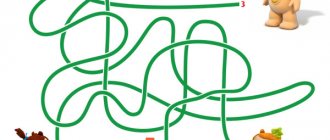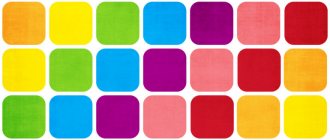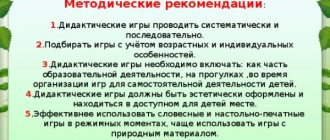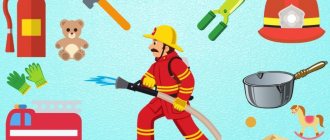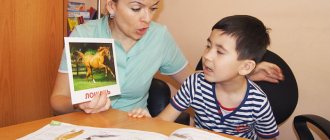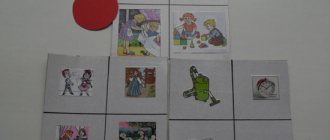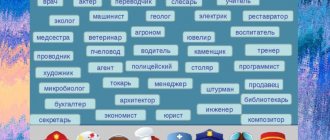Game forms are a universal means of development for preschool children. They contribute to the formation of cognitive processes and the development of the child’s personality. This article provides didactic exercises and games to develop attention in preschoolers. How we develop a child’s attention in preschool age determines how quickly the arbitrariness of this process is formed, and, consequently, the child’s preparedness for school.
Games for younger preschoolers to develop attention
Children aged 3 to 4 years old still have difficulty focusing on speech and verbal exercises. Therefore, in the development of attention it is necessary to use visual perception. It should also be taken into account that the method of cognition in younger preschoolers is visual and effective thinking. Children at this age can look at pictures, repeat actions, and compare objects. These are the games that are suitable for them to train their attention.
- Build like me! Take two sets of cubes of different colors (no more than 5). Sit next to your baby, taking one set for yourself and placing the second one in front of your child. Build a simple structure from your three or four cubes. Invite your child to build the same. If the preschooler succeeded, but without taking into account color, draw his attention to this fact. After praising your child, encourage him to do it again. As the child gets better at it, complicate the designs and add new geometric shapes (cone, cylinder...)
- What do dolls lack? Place three dolls in a row. Tell them what they are going to eat. Place a plate in front of two dolls, a spoon for two more, and also place two cups. Arrange everything so that each doll has two items. There should be utensils on the side, both necessary and unnecessary. Ask the child what is missing from the first doll, the second... Let the child complete the “setting”.
- What have you lost? Draw a simple plot picture: a house, a tree, the sun, a cloud, etc. On a separate sheet of paper, roughly repeat the basis of the drawing from the three main elements. Next, ask your child what else needs to be added, comparing both drawings.
How to develop your attention: a few general rules
Give yourself extra motivation
Before you begin work that requires distribution or switching of attention, tell yourself that at the moment you are not as interested in anything as in this matter. Think about what you will get after you achieve your goal. Think about how you will reward yourself for the results achieved.
Drink plenty of water
Three years ago, the journal Nutrition published the results of a study that experimentally proved that a lack of water in the body leads to deficits and minor attention disorders. In order to provide the body with the right amount of water, scientists recommend that women drink 9 cups daily, and men - 12.5.
Manage secondary tasks
On average, an office worker checks his email and Facebook pages up to 30 times every day. To focus on the task at hand, close all unnecessary tabs and determine a schedule for working with mail that is convenient for you:
- How many times will you open it?
- how much time will it take to spend on it?
Make a list of ways you are hindering yourself.
Psychologists at the American State University of Carolina, while tracking productive periods of work among office employees, unexpectedly found out that 44% of interruptions or unreasonable distractions were caused by the employees themselves. In the sense that no one bothered them, did not distract them from their work, did not make noise around them. The employee himself is the cause of almost half of his unjustified distractions from work
Unstable attention is the reason
Researchers point to countless reasons why people get distracted. But no one can name these reasons for you. Therefore, my advice is to choose a time and write down all your personal internal provocations for attention problems. Among them may be:
- thirst and hunger;
- desire to smoke;
- lack of sleep;
- fatigue;
- your personal stress.
Now you need to figure out exactly when these reasons appear in your life and think through preventive measures accordingly.
Sometimes, as strange as it may sound, you still have to be able to ignore
It happens that a bright picture catches your eye. This is especially dangerous when you are driving. Conscious and effective distribution of attention assumes that objects fall into the field of activity of your consciousness because they are connected with your goal, and not at all because they cause unexpected and strong emotions such as:
- astonishment;
- curiosity;
- involuntary interest;
- confusion.
People, in particular, pay for their inability to “not pay attention” by wasting time on attractive advertising. But in European countries, the ingrained practice of men and women being in a bathhouse together and no one bothering anyone is based on the ability to “not pay attention”
But in European countries, the ingrained practice of men and women being in a bathhouse together and no one bothering anyone is based on the ability to “not pay attention”
Embrace a culture of breaks
Breaks have a kind of refreshing effect. Gradually, the eye seems to “blur”, and details begin to slip away from your field of vision. By returning to the task at hand, you can look at everything with renewed eyes. Psychologist Alejandro Lleras from the University of Illinois conducted a very simple experiment and published its results in the journal Cognition. He asked 84 participants to solve 50-minute computer problems that required concentration and distribution of attention. Half of the participants took two short breaks and performed much better on the task. Lleras writes that just as your body stops feeling stimuli (such as clothes or shoes) over a certain period of time, your mind can become accustomed to an object, Lleras believes. In other words, taking a short break in the middle of a long-term task is like turning on a refresh button for your brain.
Attention games for middle preschool children
A five-year-old child knows and can do much more than a younger preschooler. He has a vocabulary of 2 thousand words, understands quantitative and qualitative relationships (more - less, stronger - weaker), and perceives verbal instructions. Accordingly, the range of games and attention exercises for preschoolers is expanding.
Exercises based on visual cues
- Lunch for Matryoshkas . Prepare a set of pyramid rings and a set of sticks of different sizes. They will serve as cutlery for the nesting dolls. Set your child the task of choosing a “plate” and “spoon” for each nesting doll in accordance with its height.
- Each item has its place . Place 6 or 8 small items in two rows. Let the preschooler carefully look at what objects are and where they are. The child turns away and counts to three. During this time, the adult swaps 2-4 objects. The child will have to return everything to its place again.
- Hostess . Mix beans, peas and buckwheat in one bowl (a spoonful of each ingredient). The child will have to sort the contents. In the same way, you can mix round, square and triangular buttons, so that the preschooler can then arrange them into three piles. In addition to developing attention, this exercise helps train fine motor skills.
- Attentive buyer. Prepare several drawings consisting of only lines. But the lines are not chaotic. They are the outlines of images of vegetables and fruits. Intrigue your preschooler by the fact that he came to a grocery store that does not have display cases. The seller will only sell those fruits and vegetables that the child finds in the picture. Example drawing:
Games for auditory attention for preschoolers
- Name day. Tell your child that it is the doll’s birthday, and guests will soon come to congratulate the birthday girl. Choose 5-6 toys (these are the guests), giving each one a name. The child seats the guests around a makeshift table and treats everyone to tea, addressing everyone by name.
- Listen to the claps! Agree with the children that they will take a certain pose when they hear the claps. 1 clap – transform into a frog by squatting and touching the floor with your hands; 2 claps – transformation into a stork standing on one leg; 3 claps – free walking. Children move freely around the room and follow commands, listening to the claps.
Tips for training attention at home
While walking in the park or on your way to work, try to notice as many little things as possible.
Examine the lawn, count the number of flowers planted in the flower bed, and pay attention to how the border is painted. Remember as many details as possible, and next time try to notice what has changed. Similar task to the previous one
Go to the store. Remember all the details of your journey. Then all the details of the store, every window display. Then go to the store again, only this time mentally. Don't do anything automatically! Often, when leaving the house, we don’t remember whether we locked the door or turned off the iron. Stop, exhale, concentrate your attention on this action. When guests come to you, try to remember what they were wearing, for example, the length and color of the dress, whether there was a tie or not, etc. Try, it would seem, such little things, but you didn’t attach any importance to them. Be curious. The more you want to know about the world, the greater your concentration endurance will be.
We are definitely not robots. It's normal to wonder and find yourself looking out the window or at the sky. And sometimes, these lapses can be good for your brain, giving it some air to breathe. However, many things in life involve focusing mindfulness. A more attentive person has more free time, is focused and successful. A person is prevented from moving on by banal laziness, which stands in the way of achieving high concentration. Some overcome it and achieve success, but, unfortunately, the majority succumb to laziness and stand in one place. Don't give in to laziness and you will succeed.
Exercises to develop attention in older preschoolers
Games for older preschoolers to develop attention are more complex. They require concentration, concentration, and also contribute to the formation of knowledge and skills necessary for entering school. Find out what your child should know by 1st grade.
Games actively involve memory and verbal logical thinking. In addition, they often contain a competitive condition, according to which the most inattentive are eliminated from the game. Older children are encouraged by such exercises, and they then perform them with interest without the participation of an adult.
- Look around. This game can be played anywhere. It is enough to decide what you need to see in your immediate environment. For example, on the way to kindergarten or to the store, name everything that has a round shape. Or focus on the perception of color and name yellow and green objects.
- Remember the pictures. Pre-prepared cards with the image of one object are used. Pictures of 10-12 pieces are laid out in a row, and the preschooler looks at them for 1-2 minutes. Then the cards are removed, and the child lists all the images that he remembers. The exercise also develops operational visual memory.
- Fish-bird-beast. A group game in which one person is the leader. The presenter, in the form of a counting rhyme, points to each participant and says: “fish-bird-beast-fish...”. This chain is repeated as much as the leader considers necessary. He can stop at any of these words and, pointing at the participant, become silent. This means that the participant must name a specific type of fish, bird or animal (depending on the last word). Names cannot be reused. If the answer is correct, the game continues with the same lineup. If a player gives an incorrect answer, he is eliminated from the game. Waiting for an answer is limited to counting one-two-three.
- Repeat and complete. It is better that 4-7 people take part in the game. The first participant names the word, the second repeats the word he heard and adds his own. The third one repeats the words that were spoken and completes the chain with his own word. The one who makes a mistake is out of the game.
- Listen - do it. Exercise helps develop attention and memory. The adult names a chain of actions without demonstrating them. He speaks slowly the first time, and repeats the second time at a normal pace. After this, the children reproduce the movements in the same order as listed by the presenter. Some examples of actions:
- Raise your right hand in front of you, raise your left hand up, lower both hands.
- Turn your head to the right, raise your left arm to the side, turn your head straight, raise your right arm to the side, lower your arms.
- Raise your left leg, clap your hands, lower your leg, jump.
This game is especially interesting for children if several people take part. Even the most absent-minded children try to listen and carry out all the actions.
The games presented in this article can be used for activities with one child or with a group of children. It’s great if an adult acts not only as an organizer, but also as a partner. Moreover, many exercises do not require special conditions. You can play with your child to benefit his attention during the most ordinary walk in the park.
When selecting exercises to develop attention in preschoolers, adhere to the principles of moving from simple to complex and the attractiveness of tasks. Also take into account the characteristics of the child’s temperament that affect the speed of switching attention.
Exercise 6 Try to remember
You can develop observation, attention and visual memory in different ways. Let's consider one of them
For example:
Let's take five different objects for children. It could be a pencil, a pen, a colored eraser, a ball, or a jump rope. Let the children look at all these items, then put them in a dark bag. The guys must take turns telling what they remember.
Older children and adults can also use this exercise.
For example:
Let's take more, seven or ten items. It could be a spoon, a mug, a glass holder, a medal, a beautiful stone, and so on. All these items must be examined quickly and carefully; one minute is given for memorization. Then put it in a dark bag and try to tell what you remember.
With each subsequent lesson, the memorization time must be reduced and the number of items increased.
Exercise 7 “Focus your attention”
Place your watch in front of the TV when an interesting cartoon or fairy tale is on. Place the child in front of the TV; the child should look at the second hand for two minutes without turning his gaze to the TV screen. The child should not be distracted by the TV, he should focus on the second hand of the clock.
Exercise 8 “Remember and Tell”
Look carefully at the picture, there are numbers drawn here, a word is written under each number. Look carefully at the picture for one minute, then close this picture and try to write all the numbers on paper and write a word under each number.
What did you get? If there are a lot of mistakes, try to remember only the top line from zero to four, then from five to nine.
Compare what is written with the picture, if there are mistakes, repeat the exercise.
Exercise 9 “Memorize and draw from memory”
Look at the following picture. Here beads are drawn, small beads are drawn with colored pencils, and large beads need to be colored.
Look carefully at the colored beads, close them and try to color the second beads from memory.
What did you get?
Check whether you have colored the beads correctly or not.
Exercise 10 “Try to guess”
Check out the new puzzle exercise. Part of the word is written here, the second part of the word is drawn in the form of a picture. You need to look carefully and say what word was intended.
After you have guessed all the words in the puzzle, close the puzzle and write all the words in alphabetical order from memory.
Developing attention: 3 tips on how to achieve success by training attention switching
It is recommended to train attention switching simultaneously in three directions:
1. Training the speed of switching attention from one process or object to another; the goal is to reduce the time it would normally take to do something else and focus entirely on that.
Place a ticking clock next to you. Start reading something not very binding
Switch your attention either to the ticking of the clock or to reading the text. Very soon you will get stuck in one thing.
Try to make progress by increasing the number of switches and the time it takes to complete this task without failure.
Lie on your back and start listening to your bodily sensations
Start with your head, then switch your attention to your arms, then to your stomach, back, etc. “Walk” through your body, including sensations in different places
Gradually increase your switching speed.
2. Developing the ability to identify the most important and secondary objects of perception, and then, if necessary, change their places so that what was previously secondary now becomes important; The task is to learn to quickly find the necessary “markers” of the situation.
Lie on your back and start listening to your bodily sensations
Start with your head, then switch your attention to your arms, then to your stomach, back, etc. “Walk” through your body, including sensations in different places
Change the “pattern” of your switches by asking yourself commands which part of your body you want to feel now
3. Independent construction or development of a ready-made “perception route” - the use of special reference signals that are needed when work processes follow a specific order; the goal is to help consciousness follow the usual path. In some cases, they even use different mnemonics
Here's how, for example, drivers were recently taught how to manage their attention:
Comrade! This is not a pro forma, sir!
Remember when going into the distance:
Clutch. Broadcast. Brake.
Turn sign. Gas. Pedal.
Draw your own route maps, following which you will switch your attention in the order specified by the map. You can rhyme the sequence of objects to make it easier to remember
As the heroine of the old film “The Sound of Music” did, drawing up a map of notes: “C – we value this sound, D – decisively forward...”
Techniques for quickly capturing attention
It often happens that it is difficult for a person to concentrate, but it must be done. If so, try these exercises.
Divide the action into cycles. For example, you need to sort documents according to a certain criterion. Tell yourself mentally “start”, pick up the document, look at it carefully and decide which pile to send it to. Next, say “stop.” This focus will help you avoid mistakes, and you will quickly concentrate on the task at hand. Reception of photographer Sasaki. Creative people tend to have their head in the clouds
Photographer Chris Sasaki decided that every time he noticed that he was distracted, he would say “Attention!” in his mind, look around and be clearly aware of what was happening around him and what he was doing. Do you feel like your attention is slipping away? This happens during long lectures or tedious seminars. Quickly change your facial expression or posture, so that distraction and drowsiness will disappear. Clearly state the purpose for which you need concentration
It's impossible to find something unless you know what you're looking for. Thus, if you need to concentrate on searching for information on the Internet, formulate your request as clearly as possible. You can also break the question into several subtasks.
Improving memory and increasing concentration
Many people around the world suffer from attention disorders and poor memory. If you are reading this article, you are definitely looking for a solution for yourself or your loved ones.
Do not think that poor memory and absent-minded attention are an irreparable problem. Training will not take much time, but it must be productive and regular, only in this case you will be able to correct the situation
Games for concentration and memory
Exercise is good! But you don’t always want to carry them out; you need self-discipline and a strong desire. However, there is a very simple and exciting way out - educational games for brain fitness
These games will not only help solve the issue of motivation, but also perfectly train memory, concentration, attention and many other qualities. And the most interesting thing is that these games keep statistics of achievements, you can beat not only your own records, but also compete with other players :)
Anagrams
Anagrams develop thinking, attention, concentration, speed of thought, and speed reading. In this game you have to choose 1 option out of 4, in which only those letters that are part of the given word are mixed
Each round a new word is given. Remember that time is limited! The faster you look for the answer, the more points you will get at the end of the game.
Tag
Tag is a great way to develop your thinking! You need to place the numbers of the dominoes one after another from top to bottom, from left to right, therefore, the empty square should be at the bottom right
The game will help you develop logical thinking, attention, and memory. You will also be able to develop the ability to calculate moves ahead without making mistakes.
Shall we play?
Game "Space"
The game "Space" will be a good trainer of your attention. A rocket will be drawn in the picture, and you will need to indicate where it is flying
The game is limited in time, this is the point, because you will have to answer as quickly as possible in order to score the most points! Can you train your attention and become one of the top players?
Game "Flank task"
The game "Flank Task" is similar to "Space", but it will be a little more difficult. The picture shows a flock of birds, and you will be required to indicate the direction of flight of the central bird. At first, you may be confused, but then it will be better, because this is already the beginning of the development of attention. Here we go?
Game "Number Reach: Revolution"
An interesting and useful game “Numeric Spanning: Revolution”, which will help you improve and develop your memory. The essence of the game is that the monitor will display numbers in order, one at a time, which you should remember and then reproduce. Such chains will consist of 4, 5 and even 6 digits. Time is limited. How many points can you score in this game?
Game "2 back"
To develop memory, I recommend an exercise like the “2 Back” game. A sequence of numbers will be displayed on the screen that you will need to remember, and then compare the number of the last card with the previous one. This is a powerful memory and brain training, this is an exercise that is available after registration, are you ready? Then go ahead!
Physical training of attention
Absent-mindedness is very clearly visible to the naked eye. Remember the image of the “absent-minded man from Basseynaya Street”, the hero was constantly unlucky, and all because he could not concentrate. Now imagine the conductor of a symphony orchestra. His movements are refined and unfussy, he is focused on his activity.
Pay attention to your behavior - do you have unnecessary habits that negatively affect the properties of attention? It could be a slouched back, tense muscles, even the habit of scratching your head or other parts of the body can become a distraction that interferes with concentration. To improve concentration, remove distractions, set yourself comfortable conditions and start working only when you are completely relaxed and not distracted by other factors.

